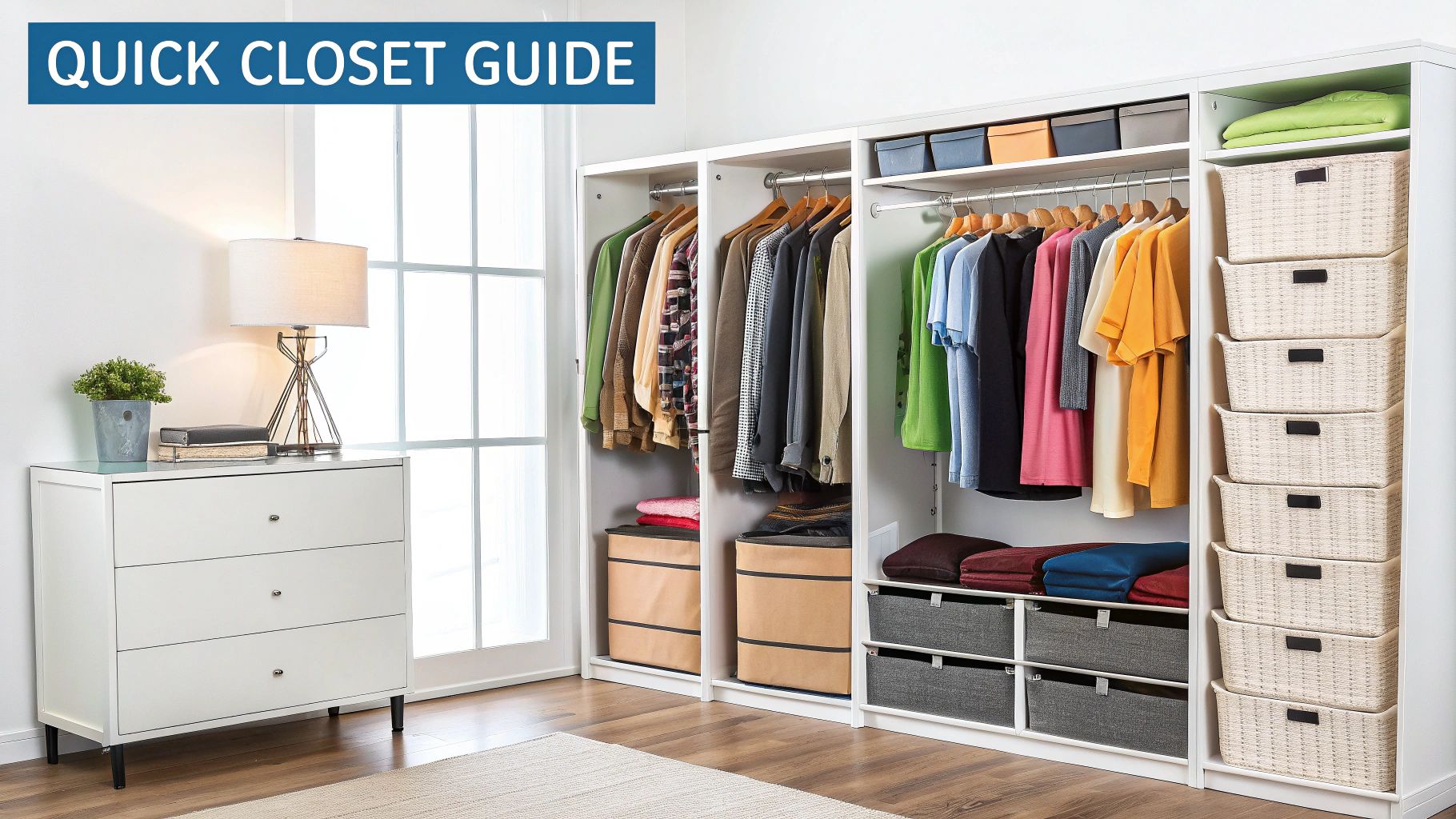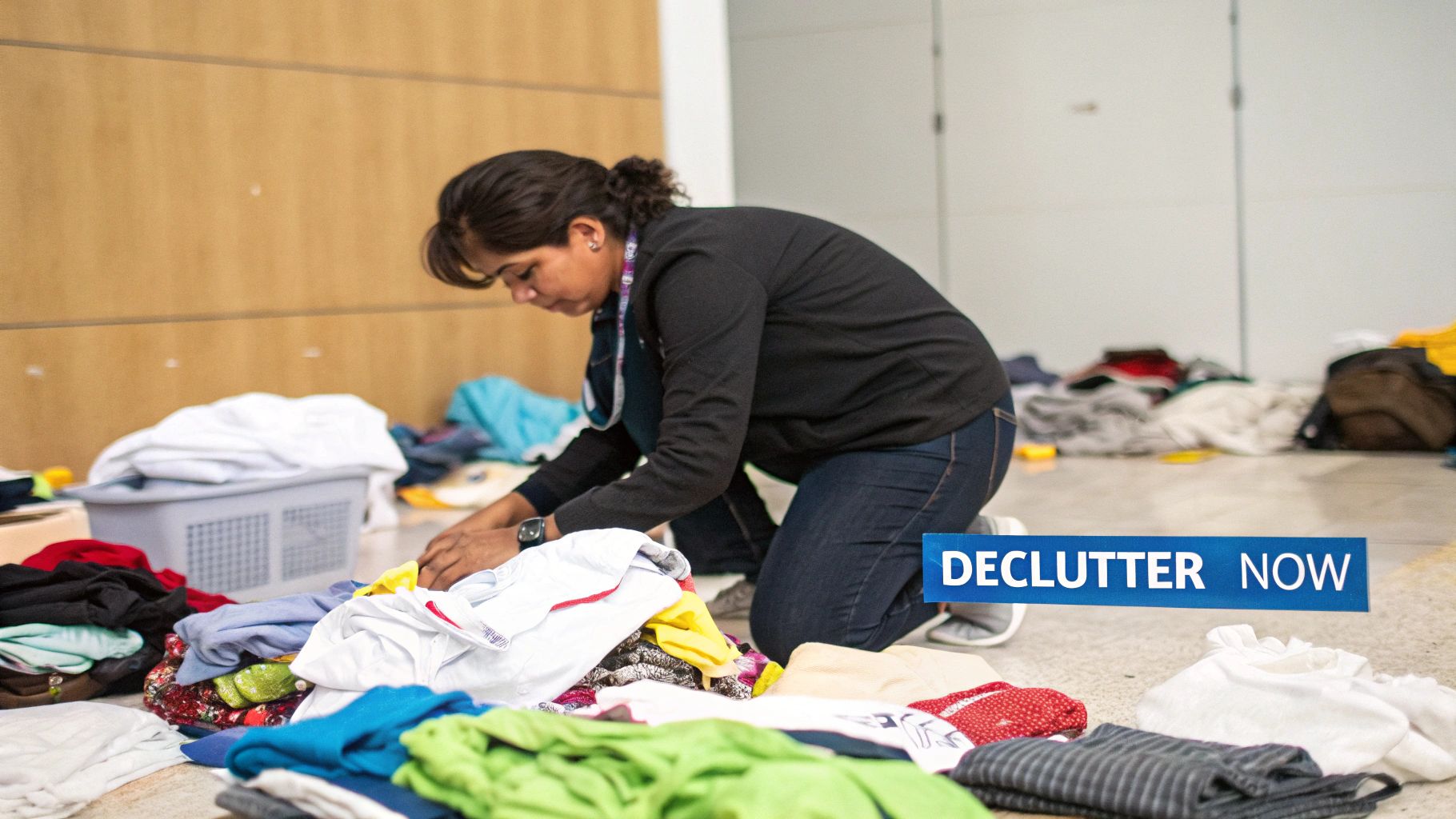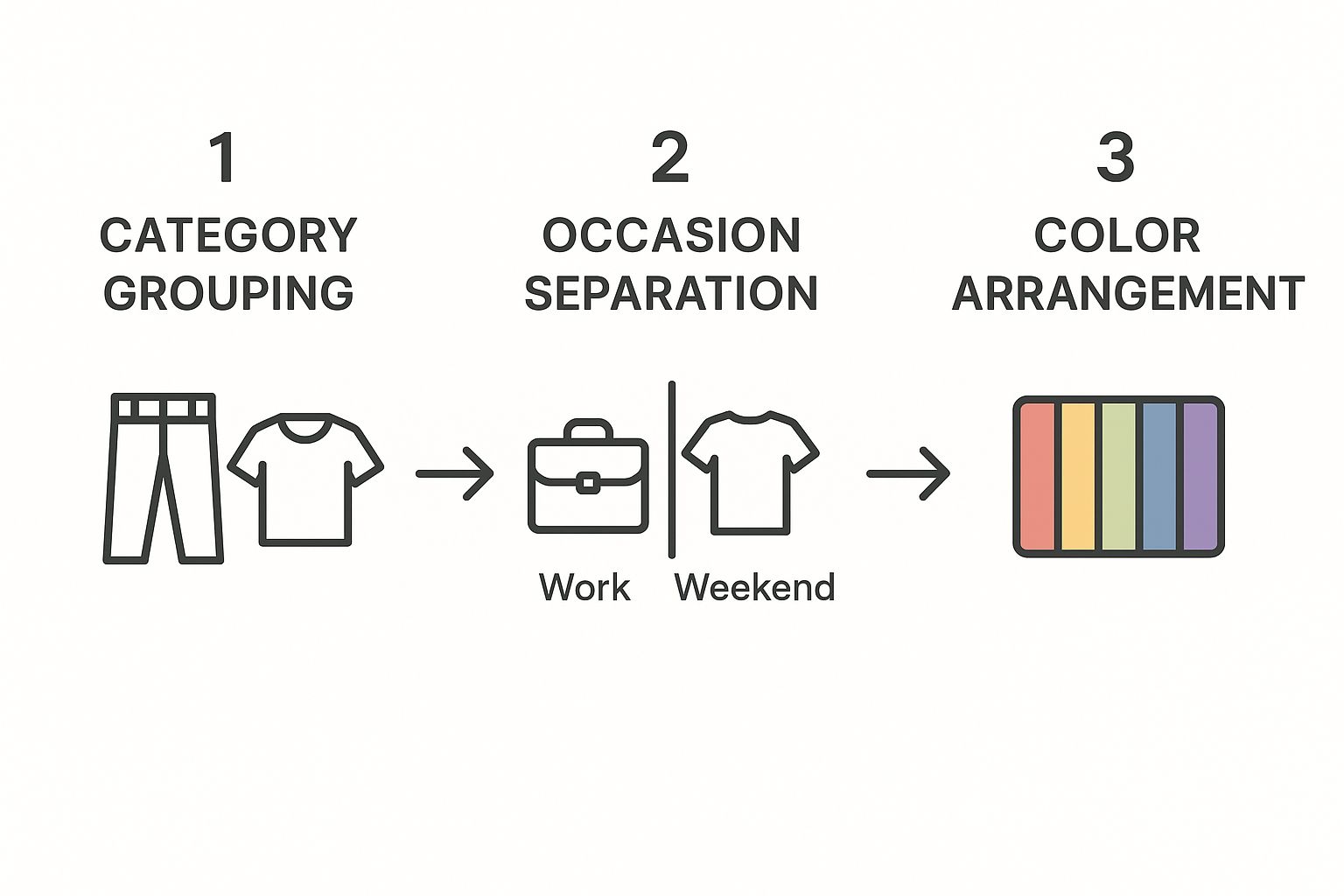How to Organize Clothes in Closet: Expert Tips & Tricks

When you learn how to organize the clothes in your closet, it really comes down to four things: ruthlessly decluttering, sorting everything into logical groups, using the right hangers, and building simple habits to keep it that way. Once you get these down, you can turn a chaotic mess into a wardrobe you actually enjoy using.
Your Quick Guide to an Organized Closet

Turning your closet from a source of daily stress into a streamlined, functional space doesn't have to be a massive weekend-long project. It really just starts with a clear plan.
Think about it—a well-organized closet saves you precious time on busy mornings and cuts down on that "I have nothing to wear" feeling. The goal isn't just to make it look pretty for a photo; it's to create a closet organization system that genuinely works for your life.
My approach is built on a few core principles that pave the way for long-term success.
- Edit Your Wardrobe: The first step is always to pare down your collection to only the pieces you truly love and actually wear.
- Sort Everything Logically: Next, you'll want to group similar items together. You can do this by category, occasion, or even color.
- Optimize the Space You Have: This is where tools like uniform hangers and closet organizers come in. They create visual calm and can instantly free up a surprising amount of rod space.
- Build Simple Habits: To stop the clutter from creeping back in, you need a few easy routines, like the classic "one in, one out" rule.
The big idea here is simple: You're not just storing clothes—you're curating and showcasing them. The point is to make it effortless to see what you own, grab what you need, and wear the things you love.
To make this even more straightforward, here's a quick look at the core tasks involved in whipping your closet into shape. This plan breaks down the process into manageable chunks.
Closet Organization Action Plan
| Task | Action | Estimated Time |
|---|---|---|
| The Great Purge | Take everything out and decide what to keep, donate, or toss. | 1-3 hours |
| Categorize & Sort | Group all kept items by type (e.g., tops, pants, dresses). | 30-60 minutes |
| Strategic Hanging | Re-hang everything on uniform, space-saving hangers. | 30-60 minutes |
| Implement a System | Arrange items by color or occasion for easy access. | 15-30 minutes |
| Establish Habits | Put a system in place for new items and regular clean-outs. | Ongoing |
Following this plan gives you a clear path from closet chaos to calm. Each step builds on the last, creating a functional and beautiful wardrobe that serves you well every single day.
Preparing Your Space for a Closet Makeover
Before you even think about pulling a single shirt off its hanger, the real work starts. It’s a mental shift. Getting your closet in order isn’t just about making things look neat; it’s about reclaiming your mornings and clearing out some of that mental fog that comes with a chaotic space. Think of this first step as laying the foundation for a closet that actually works for you, not against you.
A little prep work now saves a ton of headaches later. This is where you figure out your closet organization goals and grab the tools to make it happen. Trust me, planning ahead is the secret to creating a system you'll actually stick with.
Assess and Measure Your Closet
First things first, take a long, hard look at your closet. I mean, really look. What’s driving you crazy? Is it the mountain of shoes on the floor? That top shelf where things go to be forgotten? Pinpointing these problem areas from the start helps you focus your closet organization efforts where they’ll make the biggest difference.
Now, grab a tape measure. You need to know your closet’s exact dimensions—width, depth, and height. This isn't just busywork; knowing these numbers is critical for figuring out what closet organizers will actually fit. It tells you the true potential of your space. Don't forget to measure your hanging areas, too, noting the height for long coats or dresses versus the space you have for double-stacked rods.
Gather Your Organization Tools
Getting your supplies ready before you start is a total game-changer. It’s the difference between a smooth, satisfying project and a frustrating mess. You don’t want to be in the middle of a pile of clothes, only to realize you have nowhere to put the "donate" pile.
Here’s a quick list of what I always have on hand:
- Sorting Bins: Get a few boxes or sturdy bags and label them clearly: Donate, Sell, and Toss.
- Cleaning Supplies: A vacuum, duster, and some all-purpose cleaner are essential for giving that empty closet a much-needed deep clean.
- Uniform Hangers: Switching to a single style of hanger is one of the best closet organization tips. MORALVE's space-saving designs are perfect for this—they instantly create a clean, uniform look and give you back so much rod space.
- Storage Bins and Dividers: These are great for things you fold, like sweaters, as well as accessories and any out-of-season items.
It's clear people are looking for better home solutions. The global market for closet organizers was valued at around USD 4.03 billion in 2025 and is expected to nearly double by 2035. That's a lot of people wanting to get their closets in order!
The goal isn’t just to organize the clothes you currently own. It’s to build a functional, streamlined system for the clothes you genuinely love and wear. Preparation is what makes that possible.
With your closet measured and your tools at the ready, you’re all set to dive into the decluttering process. If you're looking for more ways to maximize your space, our guide on space-saving clothing storage has some great ideas. This initial groundwork is what will ultimately transform your closet into a space that feels calm and works beautifully.
The Art of Ruthless Decluttering

This is it. The toughest part of the whole project: letting things go. I get it—it's hard to part with an outfit you spent good money on, even if it's been collecting dust for years. The real trick to learning how to organize clothes in your closet is to change how you think about it. Instead of focusing on what you're losing, think about what you’re gaining: precious closet space, mental clarity, and a wardrobe that actually feels like you.
Don't worry, the goal here isn't to force you into a minimalist capsule wardrobe (unless that's your jam, of course!). It's simply about editing your collection down to the clothes that make you feel great right now. Seeing that mountain of clothes can be intimidating, but a solid strategy makes it manageable.
Asking the Right Questions
To sort through everything efficiently, you need a good filter. Pick up each item one by one and ask yourself a few tough questions. The key is to be brutally honest—this isn't the time for "what ifs" or "just in case."
- Have I worn this in the last 12 months? If the answer is no, it’s a prime candidate to go. The one-year rule is a classic for a very good reason.
- Does this fit me today? Not the you from five years ago, or the you that you're planning to be. Does it fit your body right now?
- Is it actually comfortable and in good shape? Be real. If it’s stained, pilling, stretched out, or just plain uncomfortable, it’s time to say goodbye.
- If I were shopping right now, would I buy this again? This question is brilliant because it cuts right through sentimental attachment and forces you to evaluate an item's real value in your current life.
This kind of intentional closet editing is becoming a massive priority for people everywhere. In fact, the global market for closet organizers is expected to reach USD 7.64 billion by 2025. That’s a lot of people deciding their peace of mind is worth investing in. If you want to explore this part of the process more, our guide on how to declutter your closet is a great place to start.
The "Life Today" Test
Here’s my favorite, and possibly most powerful, question to ask: Does this item fit the life I live today?
That bridesmaid dress from a wedding a decade ago? The power suit from a corporate job you left years back? They hold memories, for sure, but they are also taking up prime real estate in your closet.
Your closet should be a reflection of your current life and aspirations, not a museum of your past. By letting go of what no longer serves you, you make room for pieces that do.
Think of it like this: every single piece of clothing has to earn its keep. If it doesn’t make you feel fantastic or serve a clear purpose in your life right now, thank it for its service and send it on its way. This is the bedrock of a truly functional and organized closet.
Sorting Your Clothes for Effortless Mornings
You’ve done the hard work of purging, and now you’re left with a curated collection of clothes you truly love. This is where the real magic happens. The way you organize what's left will either set you up for calm, easy mornings or send you spiraling back into wardrobe chaos.
It's time to think beyond just storing your clothes. The goal is to create a closet organization system that’s genuinely intuitive for you and your routine. Forget rigid rules—there's no single "right" way to do this.
Finding Your Sorting Style
For many people, the most straightforward approach is grouping by category. This is a classic closet organization method for a reason. All your jeans live in one section, your t-shirts have their own dedicated space, and dresses hang together. When you need a specific white tee, you know exactly where to look. Simple.
But maybe your life is more segmented. If so, try sorting by occasion. This is a game-changer for anyone with a varied schedule. You can create distinct zones for workwear, weekend casual, and formal outfits. When you’re rushing to get to the office, you just head to the "work" section, completely eliminating the mental load of sifting through your Saturday loungewear.
This infographic breaks down how you can layer these methods to build a closet that truly works for you.

As you can see, the flow moves from broad categories down to specific, easy-to-find arrangements. It’s a blueprint for turning a pile of clothes into a functional, visually appealing closet system.
Adding the Finishing Touches
Once your main groups are established, you can add one final layer: sorting by color. This is my favorite part. Arranging items in a rainbow-like order within each category isn't just beautiful to look at; it's incredibly practical. It makes grabbing that specific navy blazer or cream-colored sweater almost instantaneous.
You can go from light to dark or follow the classic ROYGBIV spectrum—whatever feels most natural to you.
The most effective closet system is the one you can actually maintain. Start simple, see what works, and don’t be afraid to adjust your method as your lifestyle changes.
This kind of detailed closet organization is becoming the new standard. It’s no surprise that the built-in closet market was valued at a massive USD 29.15 billion globally in 2025. People are investing in smarter storage with features like pull-out racks and integrated lighting designed to support this exact kind of meticulous sorting. If you're curious, you can read the full research about built-in closet trends to see how home design is evolving to meet our need for order.
Why the Right Hangers Are Your Secret Weapon for a Spacious Closet
If I could give just one piece of advice for organizing a closet, it would be this: invest in a set of uniform hangers. It sounds almost too simple, but it's one of the most effective changes you can make to your closet organization.
Imagine finding room for ten more shirts on an already-packed closet rod just by swapping out your bulky, mismatched hangers. With uniform MORALVE hangers, you can instantly reclaim up to 20% more space simply because they eliminate all that wasted air between unevenly shaped hangers.
Choosing Your Go-To Hanger
For most closet makeovers, I find that slim velvet hangers are the perfect all-around choice. Their thin profile is a huge space-saver, and the non-slip surface is a lifesaver for keeping silky blouses and wide-neck tops from ending up on the floor.
Of course, for heavy winter coats or structured blazers, you'll want something with more muscle. That's where sturdy wooden hangers come in—they provide the support needed to preserve the shape of those heavier items. The key is to pick one primary style for the bulk of your clothes to create that clean, cohesive look.
- Velvet Hangers: Ultra-thin and non-slip. They’re fantastic for everyday shirts, blouses, and dresses.
- Wooden Hangers: The heavy lifters. Reserve these for your coats, suits, and jackets.
- Multi-Tier Hangers: These are my go-to for consolidating bulky items like pants or skirts and maximizing vertical space.
“Switching to uniform slim hangers freed up a full foot of hanging space in my closet overnight.”
Tiered Hangers: The Ultimate Space-Savers
When you're really tight on space, multi-tier pant and skirt hangers are absolute game-changers. They let you hang several pieces of clothing in the same vertical space that a single, traditional hanger would occupy.
Think about it: a five-tier pant hanger takes the place of five separate hangers, freeing up a significant chunk of your closet rod. This not only saves precious real estate but also keeps your pants and skirts neatly organized and wrinkle-free.
To get the most out of them, I usually attach garments in a cascading order to keep the weight balanced. It's also a good idea to leave a little breathing room at either end of the rod so you can slide things around easily.

This setup shows how you can mix slim velvet hangers and tiered hangers to create specific zones in your closet. It’s a perfect example of how different hanger types can work together to use every last inch of hanging space effectively.
A Few Pro Tips for Hanging
- Delicate fabrics? Always reach for padded or velvet hangers for anything sheer, silky, or prone to stretching. For some lightweight tops, I even use small clips at the shoulder seams to prevent any distortion.
- Heavy coats? Give them the support they deserve with broad-shouldered wooden hangers. This is crucial for maintaining their shape over time.
- Keep it balanced. Try to group items of similar weight together. This prevents your closet rod from bowing in the middle under a lopsided load.
How to Tame Your Hanger Collection
Don't let your extra hangers become part of the clutter! A simple trick is to designate a hook or a small section at the front of your closet as the "empty hanger zone."
When you take a piece of clothing to wear, just move the empty hanger to that spot. It makes them easy to grab when you're putting away laundry. Every few months, do a quick check for any bent or broken hangers and toss them—a damaged hanger can ruin your clothes.
If you want to dive deeper, we have a whole guide on how to store hangers properly.
At a Glance: Hanger Types and Their Strengths
| Hanger Type | Thickness | Best For |
|---|---|---|
| Velvet | 0.4 inch | Delicates, blouses, everyday shirts |
| Wood | 0.8 inch | Heavy coats, suits, jackets |
| Tiered | 0.5 inch | Pants, skirts, scarves |
Making Your Mornings Easier
Once your hangers are sorted, arrange your clothes in a way that makes sense for your routine. Grouping by category (workwear, casual, formal) or even by color can save you a surprising amount of time when you're getting dressed.
For instance, I like to keep all my work blouses in one section and weekend t-shirts in another. It makes pulling an outfit together so much faster. A simple tag on each section can make finding what you need even more of a breeze.
Ultimately, a small investment in the right hangers pays you back every single day with an organized closet, longer-lasting clothes, and less stressful mornings.
A well-chosen hanger selection is the secret to a closet that works as hard as you do.
Maintaining Your Newly Organized Closet
You’ve done it. After all that sorting and purging, your closet finally looks like a masterpiece of order. But here’s the secret nobody tells you: the real trick to knowing how to organize clothes in a closet for good isn't the big overhaul—it's the small habits you build afterward. An organized closet isn't a one-and-done project; it’s an ongoing routine.
The whole point is to stop clutter before it even has a chance to creep back in. This doesn't mean hours of upkeep. Honestly, a few intentional actions are all it takes to keep your closet organization in check, making sure all your hard work wasn't for nothing.
Build Sustainable Daily Habits
Your most powerful tool for keeping things in order is the five-minute nightly tidy-up. Seriously, that’s it. Before you crash for the night, just take those few minutes to put things back where they live. Hang up the jacket you threw on the chair, put your shoes back on the rack, and tidy up any accessories lying around. It’s a tiny investment that prevents a small mess from turning into a full-blown disaster zone.
Another game-changer is the 'one in, one out' rule. This one is non-negotiable if you want to avoid an overflowing closet. The moment you bring home a new shirt, an old one has to go. This simple practice keeps you from mindless shopping and ensures your wardrobe stays intentionally curated, not just stuffed.
Maintaining an organized closet is less about marathon cleaning sessions and more about consistent, small-scale actions. These simple habits are what separate a temporary fix from a lasting solution.
Implement a Seasonal Rotation
A seasonal swap is your best bet for keeping your closet relevant and easy to use all year long. A couple of times a year, set aside an hour or so to rotate your out-of-season clothes with the current ones. This keeps what you’re actually wearing front and center, which makes getting dressed in the morning so much faster.
Here’s a simple way to tackle it:
- Store Off-Season Items Properly: Grab some under-bed containers or bins for a high shelf to store clothes you won't touch for months.
- Use the Swap as a Mini-Declutter: As you pack things away, give them a quick once-over. Did you even wear that sweater last winter? If the answer's no, it might be time to donate it.
- Refresh Your Space: Before you bring in the clothes for the new season, give your shelves and hanging rods a quick wipe-down.
This seasonal refresh does more than just keep your closet functional. It gives you a built-in chance to reassess what you own and make sure the space is still working for you, no matter what the weather is doing.
Your Closet Organization Questions, Answered
Even the best-laid plans can hit a snag. As you start organizing your closet, you'll probably run into a few specific questions. I've been there, and getting these little details right is what makes the whole system stick long-term.
Let's tackle some of the most common questions I hear from people who are just diving into their closet cleanout.
What Supplies Do I Really Need to Start?
It's so easy to go overboard and buy a mountain of organizing gadgets, but you truly don't need much to see a huge difference. My advice? Start with the absolute must-haves for closet organization and add more only if you find you need them.
- Sorting Bins: This is non-negotiable for the first phase. Grab three boxes or even sturdy bags and label them: Donate, Sell, and Toss. It makes the decision-making process so much faster.
- Good Hangers: This is the single most important investment. Switching to a uniform set of slim, non-slip hangers, like the ones from MORALVE, is a game-changer. It instantly creates a clean, cohesive look and saves a shocking amount of space.
- Drawer Dividers: If you have drawers, these are a lifesaver. They keep your folded t-shirts, workout clothes, and socks from turning into one big, jumbled pile.
Don’t get caught up in thinking you need a fancy, custom closet system. The real goal is creating a space that works for you, and often the simplest tools are the most powerful.
How Often Should I Be Decluttering My Closet?
For a big, deep cleanout, I recommend doing it twice a year. The easiest way is to time it with the change of seasons when you're already swapping your sweaters for sundresses (or vice-versa). It’s the perfect, built-in moment to evaluate what you actually wore and what’s just been taking up space.
To keep things tidy in between, try this little trick: keep a donation bag inside your closet. The next time you put something on and it just doesn't feel right anymore, toss it straight into the bag instead of putting it back on the rack. When the bag is full, you're ready for a drop-off. This simple habit stops the clutter from creeping back in.
Are Special Hangers Actually Worth the Money?
One hundred percent, yes. A random mix of bulky plastic, wire, and wooden hangers is one of the biggest culprits of a cramped closet. I've seen clients gain back as much as 20% of their hanging space just by switching to a uniform set of slim hangers.
And when it comes to specialty hangers, like multi-tier pant hangers, the value is even clearer. Think about it: instead of five pairs of pants eating up a foot of rod space, a single tiered hanger holds them all in the same slim footprint. It's one of the quickest and most satisfying closet organization upgrades you can make.
Ready to see what the right hangers can do for your closet? Take a look at the space-saving solutions from MORALVE and find out just how much more room you really have. Shop the collection at moralve.com.


Leave a comment